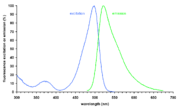
SYBR Green
Encyclopedia
SYBR Green I is an asymmetrical cyanine dye used as a nucleic acid
stain
in molecular biology
. SYBR Green I binds to DNA
. The resulting DNA-dye-complex absorbs blue light (λmax = 497 nm) and emits green light (λmax = 520 nm). The stain preferentially binds to double-stranded DNA, but will stain single-stranded DNA with lower performance. SYBR green can also stain RNA
with a lower performance than DNA.
 SYBR green finds usage in several areas of biochemistry
SYBR green finds usage in several areas of biochemistry
and molecular biology
. It is used as a dye for the quantification of double stranded DNA in some methods of real time PCR. It is also used to visualise DNA in gel electrophoresis
. Higher concentrations of SYBR green can be used to stain agarose gels in order to visualise the DNA present. In addition to labelling pure nucleic acids SYBR green can also be used for labelling of DNA within cells for flow cytometry
and fluorescence microscopy. In these cases RNase treatment may be required to reduce background from RNA in the cells.
ethidium bromide
, as both safer to work with and free from the complex waste disposal issues of ethidium. However anything capable of binding DNA with high affinity is a possible carcinogen
, including SYBR.
In a study using the Ames test
, which measures the ability of chemicals to cause mutations, when assayed at the same concentration there was no clear pattern in the relative mutagenicities of ethidium bromide and SYBR green I. Ethidium bromide was more mutagenic at higher concentrations, however SYBR green I could not be tested at these concentrations as it was cytotoxic at a much lower concentration than ethidium bromide. SYBR green I readily penetrates living cells, whereas ethidium bromide is efficiently excluded from live cells.
Nucleic acid
Nucleic acids are biological molecules essential for life, and include DNA and RNA . Together with proteins, nucleic acids make up the most important macromolecules; each is found in abundance in all living things, where they function in encoding, transmitting and expressing genetic information...
stain
Stain
A stain is a discoloration that can be clearly distinguished from the surface, material, or medium it is found upon. Stains are caused by the chemical or physical interaction of two dissimilar materials...
in molecular biology
Molecular biology
Molecular biology is the branch of biology that deals with the molecular basis of biological activity. This field overlaps with other areas of biology and chemistry, particularly genetics and biochemistry...
. SYBR Green I binds to DNA
DNA
Deoxyribonucleic acid is a nucleic acid that contains the genetic instructions used in the development and functioning of all known living organisms . The DNA segments that carry this genetic information are called genes, but other DNA sequences have structural purposes, or are involved in...
. The resulting DNA-dye-complex absorbs blue light (λmax = 497 nm) and emits green light (λmax = 520 nm). The stain preferentially binds to double-stranded DNA, but will stain single-stranded DNA with lower performance. SYBR green can also stain RNA
RNA
Ribonucleic acid , or RNA, is one of the three major macromolecules that are essential for all known forms of life....
with a lower performance than DNA.
Uses

Biochemistry
Biochemistry, sometimes called biological chemistry, is the study of chemical processes in living organisms, including, but not limited to, living matter. Biochemistry governs all living organisms and living processes...
and molecular biology
Molecular biology
Molecular biology is the branch of biology that deals with the molecular basis of biological activity. This field overlaps with other areas of biology and chemistry, particularly genetics and biochemistry...
. It is used as a dye for the quantification of double stranded DNA in some methods of real time PCR. It is also used to visualise DNA in gel electrophoresis
Gel electrophoresis
Gel electrophoresis is a method used in clinical chemistry to separate proteins by charge and or size and in biochemistry and molecular biology to separate a mixed population of DNA and RNA fragments by length, to estimate the size of DNA and RNA fragments or to separate proteins by charge...
. Higher concentrations of SYBR green can be used to stain agarose gels in order to visualise the DNA present. In addition to labelling pure nucleic acids SYBR green can also be used for labelling of DNA within cells for flow cytometry
Flow cytometry
Flow cytometry is a technique for counting and examining microscopic particles, such as cells and chromosomes, by suspending them in a stream of fluid and passing them by an electronic detection apparatus. It allows simultaneous multiparametric analysis of the physical and/or chemical...
and fluorescence microscopy. In these cases RNase treatment may be required to reduce background from RNA in the cells.
Safety
SYBR Green I is marketed as a replacement for the mutagenMutagen
In genetics, a mutagen is a physical or chemical agent that changes the genetic material, usually DNA, of an organism and thus increases the frequency of mutations above the natural background level. As many mutations cause cancer, mutagens are therefore also likely to be carcinogens...
ethidium bromide
Ethidium bromide
Ethidium bromide is an intercalating agent commonly used as a fluorescent tag in molecular biology laboratories for techniques such as agarose gel electrophoresis. It is commonly abbreviated as "EtBr", which is also an abbreviation for bromoethane...
, as both safer to work with and free from the complex waste disposal issues of ethidium. However anything capable of binding DNA with high affinity is a possible carcinogen
Carcinogen
A carcinogen is any substance, radionuclide, or radiation that is an agent directly involved in causing cancer. This may be due to the ability to damage the genome or to the disruption of cellular metabolic processes...
, including SYBR.
In a study using the Ames test
Ames test
The Ames test is a biological assay to assess the mutagenic potential of chemical compounds. A positive test indicates that the chemical is mutagenic and therefore may act as a carcinogen, since cancer is often linked to mutation. However, a number of false-positives and false-negatives are known...
, which measures the ability of chemicals to cause mutations, when assayed at the same concentration there was no clear pattern in the relative mutagenicities of ethidium bromide and SYBR green I. Ethidium bromide was more mutagenic at higher concentrations, however SYBR green I could not be tested at these concentrations as it was cytotoxic at a much lower concentration than ethidium bromide. SYBR green I readily penetrates living cells, whereas ethidium bromide is efficiently excluded from live cells.
Related dyes
Similar cyanine dyes:- SYBR Green II
- SYBR Gold
- YO (Oxazole Yellow)
- TO (Thiazole Orange)
- PG (PicoGreen)

